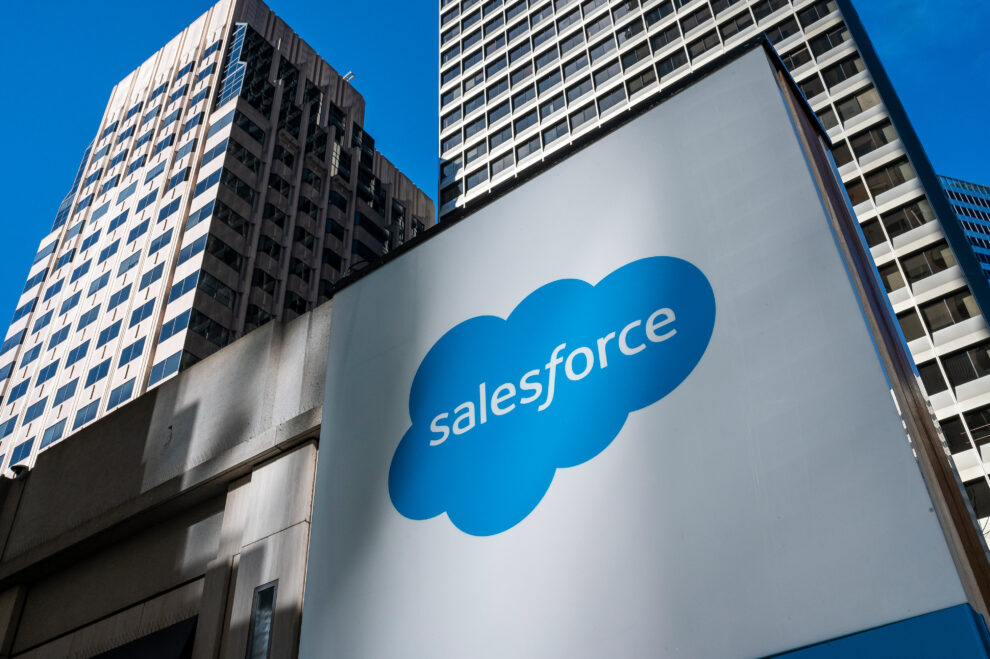
A sigh of relief is in order. Salesforce shares jumped more than 4% in extended trading Wednesday after the enterprise software giant beat sales and earnings expectations in the second quarter. The company may have maintained its full-year revenue outlook, but that was taken as good enough after last quarter’s debacle. Plus, an increase to its margin forecast showed Salesforce remains committed to profitable growth. Revenue increased 8% year over year to $9.33 billion in the quarter, beating the $9.23 billion expected by analysts, according to estimates compiled by LSEG. Adjusted earnings per share of $2.56 increased 21% on an annual basis and topped the $2.36 predicted by analysts, LSEG data showed. Adjusted operating margin expanded to 33.7% in the three months ended July 31, beating the consensus estimate of 31.95%, according to FactSet. On a Generally Accepted Accounting Principles (GAAP) basis, quarterly operating margin came in at 19.1%, above the expected 18.38%. Salesforce Why we own it : Salesforce is a leading enterprise software tool for companies across all industries, helping employees to better communicate with colleagues internally and with their customers. The company’s balance of margin expansion with the potential for faster top-line growth should lead to strong earnings growth. Competitors : SAP , Microsoft , HubSpot Most recent buy : Dec. 21, 2022 Initiation : June 15, 2018 Bottom line Investor expectations were low into Salesforce’s release Wednesday after the company shockingly missed on revenues and lowered its GAAP margin guidance last quarter — a double whammy to the profitable growth thesis that’s been central for well over a year. It led to the stock having its worst day since 2004 . The results were cleaner this go around with key beats on revenue, remaining performance obligation (RPO) and the current RPO (cRPO), along with an improved adjusted operating margin guidance. RPO represents contracted revenue that has not yet officially been recorded, while cRPO is the amount expected to be recorded in the next 12 months. Investors pay close attention to the changes in these metrics to help them gauge the health and momentum of the business. It’s still tough to see Salesforce’s revenues only grow 8% on an annual basis when this is a traditional double-digit grower, but we’re willing to take some topline softness if it’s temporary and margins are expanding. Fortunately, the margin story got back on track this quarter, and the company has an upbeat story to tell about a pair of new AI tools for salespeople that will be generally available in October. Working against Salesforce is an emerging idea that artificial intelligence could be foes — not friends — to enterprise software companies if their customers can use AI to develop in-house software tools to manage their data. CEO Marc Benioff pushed back on this idea early in the conference call with the following remarks: “I have been out there very disappointed with the huge amount of money that so many of these customers have wasted on AI. They are trying to DIY their AI. It’s not so unlike when we first saw cloud emerge or even other technologies where they feel like they have to roll their own, build it themselves, get in the weeds, try to figure out, and they’re not going to do it better than we’re going to do it,” Benioff argued. “We’re a professional enterprise software company. This is what we do. And we do it with the trust and scale that they need.” Salesforce’s new AI tools — which it is calling autonomous AI sales agents — may be the company’s answer to this negative thesis. One of the AI agents is focused on fielding inbound inquiries on behalf of salespeople. The other is geared toward improving a salesperson’s pitching and negotiating skills. Benioff sounded very bullish on the products, saying he expects thousands of customers will be using this platform by the beginning of the next fiscal year. The company can use its annual Dreamforce conference in September to make a big sales pitch. Another question on Wall Street is that if a company uses AI to become more efficient and can accomplish more with fewer workers, how will that impact Salesforce’s mostly seat-based business model? A seat, in software license terms, is a registered user of the product. A company may need fewer seats if the business is run more efficiently. When asked about this during the conference call Q & A, executives reminded the analyst that Salesforce also offers many consumption-based products as well, such as its data analytics and commerce applications. Those shouldn’t be impacted. Putting it all together, Salesforce delivered a much better quarter and more upbeat conference call than its previous report in May, mostly due to excitement around new product innovations. The next task for Salesforce is proving these new AI products will become a material driver of revenue growth. Again, that is where Dreamforce is key. We reiterate our 2 rating and $300 price target on Salesforce as we take a wait-and-see approach around its AI products. We also won’t be surprised to see a hangover in tech stocks Thursday after fellow Club holding Nvidia ‘s better-than-expected results failed to satisfy Wall Street’s lofty expectations. CRM YTD mountain Salesforce’s year-to-date stock performance. Quarterly results From a macro perspective, there wasn’t much talk about the buying environment or whether widely expected interest rate cuts from the Federal Reserve will spur more deals. When it was pointed out that Salesforce’s Americas region, its largest, grew only 8% in the quarter, COO Brian Millham attributed the softness to a “measured buying environment” and not a market saturation. Millham added that he believes the region can return to double-digit growth through its new technology, innovations, and multi-cloud deals. Across all regions, multi-cloud deals accounted for about 80% of total new business and the company signed 1,500 AI deals in the quarter. Think of a cloud as a service designed for a specific business function, such as sales, customer service and marketing. Deals involving multiple clouds are important because they mean more business and stickier relationships with the specific customer. On an operating level, we were pleased to see better-than-expected margins and a raise to the full-year outlook despite stepped-up investments in growth opportunities, like the two new AI sales agents. Elsewhere, CFO Amy Weaver, who has been leading Salesforce’s transformation to profitable growth, announced Wednesday night that she is stepping down from her role. She will remain CFO until a successor is appointed and be an advisor to the company after that. Management wisely stepped up its buyback activity in the quarter, likely taking advantage of the stock trading in the low $200s a share throughout June. The company bought back $4.3 billion worth of stock in the quarter, almost double the $2.2 billion repurchased in the quarter before. This helped reduce the diluted share count by 1% year over year. Guidance For its 2025 fiscal year, Salesforce backed its full year revenue guide of $37.7 billion to $38 billion, an 8% to 9% increase over the previous year. The midpoint is roughly in line with the consensus estimate. Although Salesforce isn’t delivering a ton of revenue upside, the company is remaining disciplined on costs, evidenced by management raising its full-year operating margin outlook. The company now sees adjusted margins of 32.8%, up from its prior view of 32.5%. That’s translating to a bump in the adjusted EPS forecast. Salesforce now expects to earn between $10.03 and $10.11 a share, up from $9.68 to $9.76. The new midpoint of $10.07 is well above the consensus estimate of $9.89. For the third quarter, Salesforce forecasts revenues of $9.31 billion to $9.36 billion, which is below the $9.4 billion estimate. But despite the lower revenues, Salesforce’s adjusted EPS forecast range of $2.42 to $2.44 was slightly better than the $2.42 estimate. (Jim Cramer’s Charitable Trust is long CRM and NVDA. See here for a full list of the stocks.) As a subscriber to the CNBC Investing Club with Jim Cramer, you will receive a trade alert before Jim makes a trade. Jim waits 45 minutes after sending a trade alert before buying or selling a stock in his charitable trust’s portfolio. If Jim has talked about a stock on CNBC TV, he waits 72 hours after issuing the trade alert before executing the trade. THE ABOVE INVESTING CLUB INFORMATION IS SUBJECT TO OUR TERMS AND CONDITIONS AND PRIVACY POLICY , TOGETHER WITH OUR DISCLAIMER . NO FIDUCIARY OBLIGATION OR DUTY EXISTS, OR IS CREATED, BY VIRTUE OF YOUR RECEIPT OF ANY INFORMATION PROVIDED IN CONNECTION WITH THE INVESTING CLUB. NO SPECIFIC OUTCOME OR PROFIT IS GUARANTEED.
Salesforce headquarters in San Francisco, California, US, on Wednesday, Nov. 29, 2023.
David Paul Morris | Bloomberg | Getty Images
A sigh of relief is in order.
Salesforce shares jumped more than 4% in extended trading Wednesday after the enterprise software giant beat sales and earnings expectations in the second quarter. The company may have maintained its full-year revenue outlook, but that was taken as good enough after last quarter’s debacle. Plus, an increase to its margin forecast showed Salesforce remains committed to profitable growth.






